Transit for Howard County and Rethinking Sprawl and Refocusing upon the Core
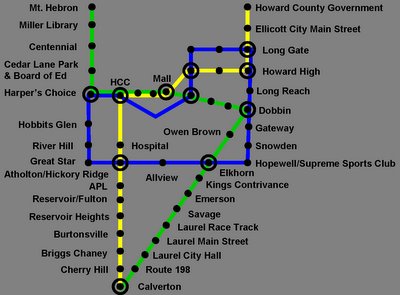 Proposed heavy rail transit system for Howard County, from the Howard County blog.
Proposed heavy rail transit system for Howard County, from the Howard County blog.A blog from Howard County, Columbia Compass, mentioned one of my blog entries and Dan Malouff's map showing a possible scenario for a regional railroad passenger system that combines and transcends the present VRE and MARC services, which for the most part are focused on ferrying people from distant places to work in either Washington or Baltimore, rather than providing true regional railroad service on the lines of what is done in the NYC, Boston, or Philadelphia regions.
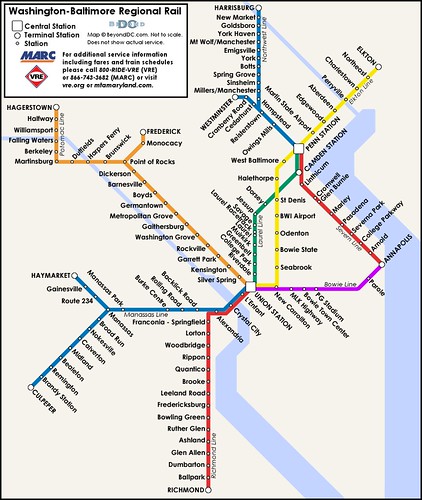 Dan's map...
Dan's map...In an e-conversation Dan mentioned that some things not included here were being discussed at the time in other ways, such as a light rail system for Southern Maryland, which now seems to be off the table, meaning it might be worth adding a Southern Maryland rail line to this map.
Also, Ken Firestone mentioned extending service to Wilmington, Delaware, and then within a few days, this article, "Rail-service hopes rise: State promises to talk to Amtrak about extending into Cecil," surfaced in the Cecil County Whig. From the article:
County and town officials have long been calling for rail service in Cecil County to fill a 20-mile gap between Perryville and Newark, Del. The hole is the only gap in commuter service in 460 miles of rail lines between Virginia and Connecticut. State officials, however, have refused to budge on their stance against an expanded rail service.
Flanagan agreed to pursue Amtrak service but did not go as far as to offer his support for an extension of the MARC commuter rail’s Penn Line farther into the county. The problem with the extension, he said, is that it would not be productive enough to justify its cost. The extension would also create havoc on the Penn Line’s schedule, he said. “It’s impossible to run trains up here and maintain the service as it exists,” Flanagan said.
This is a perfect illustration of why we need one regional railroad passenger transportation system, rather than an overly constrained commuter focus, one that transcends narrow state-centric thinking, in favor of regional thinking.
By connecting MARC to Newark, Delaware, the MARC system could be connected to SEPTA, the transit system of the Philadelphia region. A one-way ticket to Perryville from DC costs $11.00. A one-way ticket from DC to to Newark Delaware (20 miles beyond Perryville), costs $57.00. SEPTA from Newark, Delaware to Philadelphia costs $7. The fare from DC to Philadelphia via Amtrak is $58. (Of course, the round trip fare via a Chinese bus from DC to Philadelphia is cheaper than the train, and practically a non-stop trip.)
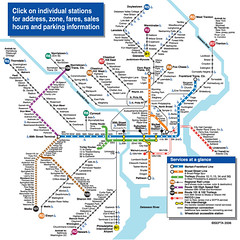 SEPTA map.
SEPTA map.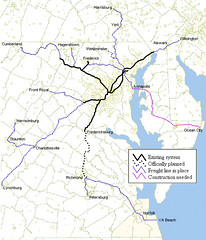 Another perspective showing the possibilities within the area for the creation of a regional rail service, from BeyondDC.
Another perspective showing the possibilities within the area for the creation of a regional rail service, from BeyondDC.Now while I don't have problems with extending the subway lines at their ends, and improving transit-based mobility in the counties throughout the region, the reality is that this isn't about improving transit and mobility for Washington DC (my primary interest) as much as it is about enabling more sprawl and more development. Although anything that brings people to the city on transit rather than in their cars is always a good thing. (Last year I was flying out to Portland on the same day as an anti-war march in DC, and I was shocked to see at the Greenbelt station that charter buses were disgorging mobs of protesters to take the subway into the city, allowing the buses to avoid traffic.)
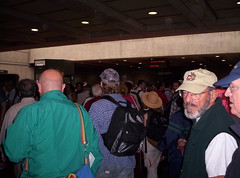 A "mob" at Greenbelt Station, September 24, 2005.
A "mob" at Greenbelt Station, September 24, 2005.Most of the "smart growth" energies are focused on creating "better" suburban development, not about recentralizing, revitalizing, and repopulating the core. Recentralization, not polycentric development, is the thesis of the book Cities in Full by Steve Belmont, which is one of the best books in urban planning since Death and Life of Great American Cities.
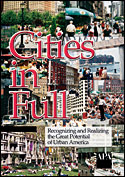 Steve Belmont embraces Jane Jacobs' much acclaimed prescription for urban vitality—high densities, mixed land uses, small blocks, and variously aged buildings. He examines neighborhoods that adhere to her precepts and those that do not and compares the results. He examines the destructive forces of decentralization and shows how and why they must be turned into forces of renewal.
Steve Belmont embraces Jane Jacobs' much acclaimed prescription for urban vitality—high densities, mixed land uses, small blocks, and variously aged buildings. He examines neighborhoods that adhere to her precepts and those that do not and compares the results. He examines the destructive forces of decentralization and shows how and why they must be turned into forces of renewal.Better development is important for the suburbs, but at the same time, focusing "growth" on extant infrastructure and places tends to be the "smartest" policy, not merely a "smart" or "smarter" policy.
In fact, this is discussed in yesterday's USA Today cover story, "How will the USA cope with unprecedented growth?." From the article:
• Ready made cities
Detroit, Washington and St. Louis supported hundreds of thousands more residents in 1950 than they do today. Dozens of cities across the country are well past their heyday but still have all their streets, roads, power lines and water supplies in place. If only people would return.
Cleveland had a population of about 915,000 in 1950. Today, it has less than half (452,208).
"We have a unique opportunity here," says Joseph Marinucci, president and CEO of the Downtown Cleveland Alliance, which advocates investment downtown. Cultural and aesthetic amenities, such as a symphony and a riverfront, already exist. Housing is cheaper and traffic lighter than in many other metro areas. "We'll be very well-positioned to garner our share of growth," Marinucci says.
Los Angeles native Ivan Schwarz just moved to Cleveland with his wife and 16-month-old daughter. A television producer who also finds locations for shows (HBO's Entourage and NBC's My Name is Earl), Schwarz is the new vice president of the Greater Cleveland Film Commission, one of the city's attempts to lure industry. "In L.A., there's so many people, everywhere you go is a problem," says Schwarz, 44. "This is such a community. ... Houses are more affordable.
Note that some of the Maryland "Extra" sections of the Post ran a story about Maryland's recent "Reality Check" exercise , "Confine Growth to Urban Areas, Residents Urge," subtitled "Report Supports Saving Farmland."
The prevailing belief was rather than sprawl further outwards, focus development on the Washington and Baltimore regions.
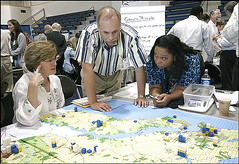 One of the workshops leading to the "Reality Checks Plus" report was in June for Southern Maryland leaders. From left, Karen Edgecombe, George Leah and Dawn Tucker ponder choices. (By James A. Parcell -- The Washington Post)
One of the workshops leading to the "Reality Checks Plus" report was in June for Southern Maryland leaders. From left, Karen Edgecombe, George Leah and Dawn Tucker ponder choices. (By James A. Parcell -- The Washington Post)Click here for the Reality Check-Imagine Maryland website, and here for the report "Today's Vision, Tomorrow's Reality."
Labels: sprawl, transportation planning, urban revitalization



0 Comments:
Post a Comment
<< Home